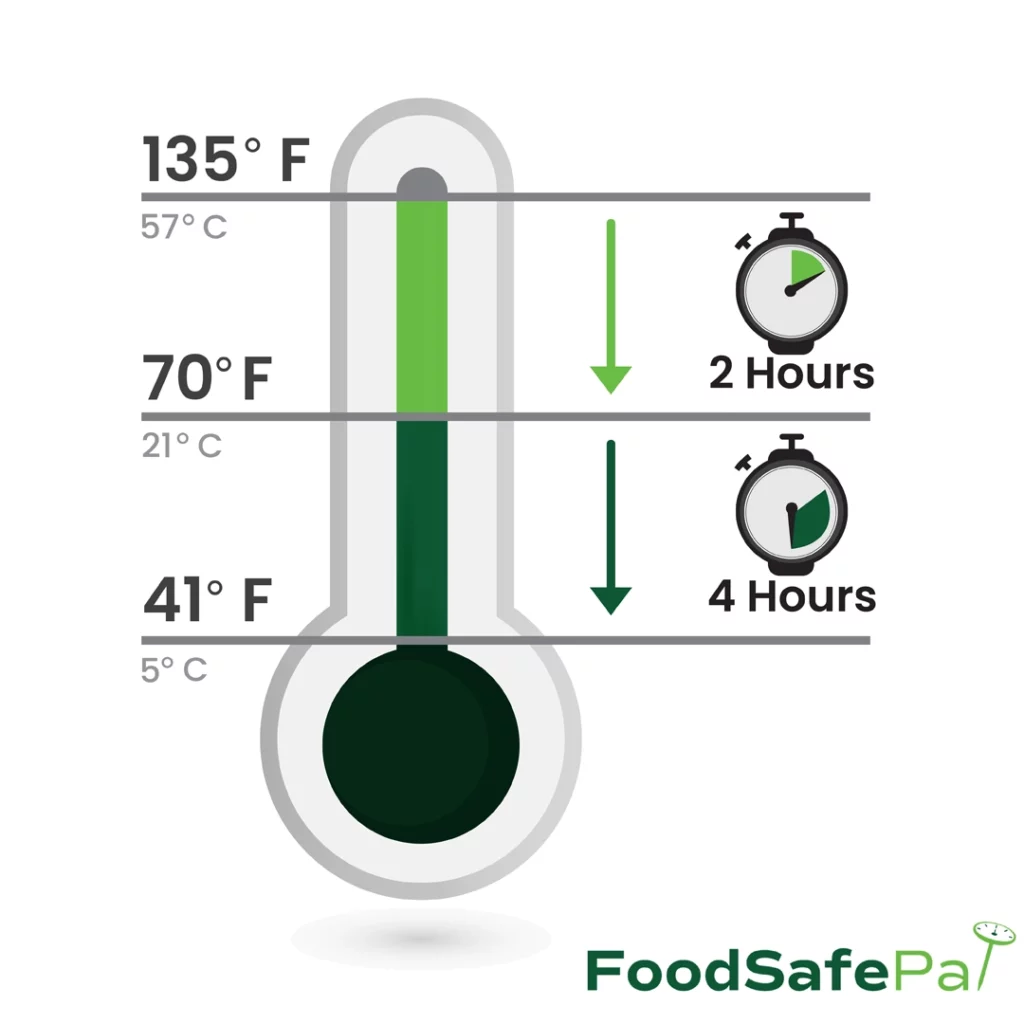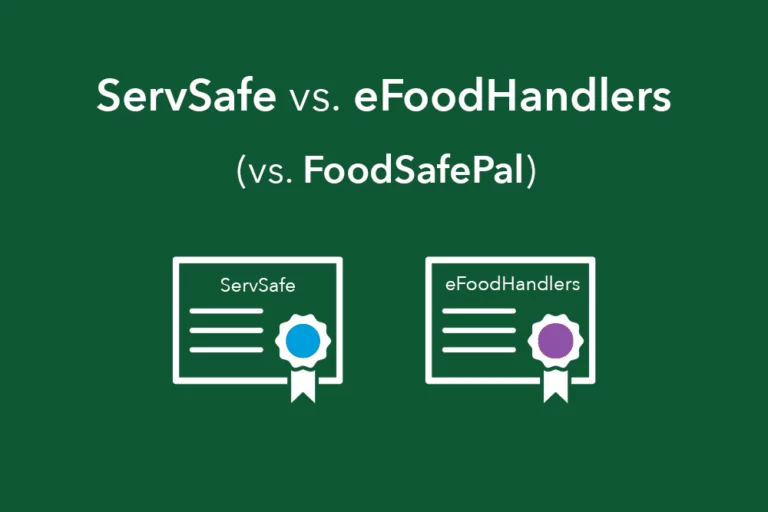The Temperature Danger Zone: For Food Handlers
The temperature danger zone is the temperature range in which bacteria multiply rapidly.
This is why it’s important to store certain foods out of this range and move them through it as quickly as possible when cooling or reheating food.
This article explains everything food handlers need to know about the temperature danger zone and how to keep food safe.

The tale of two temperature danger zones
The temperature danger zone is the temperature range at which the rate of bacteria growth accelerates.
Food kept in the temperature danger zone for too long allows harmful strains of bacteria like E. Coli and Salmonella to grow to levels harmful enough to make people sick.
The temperature danger zone for food handlers and others in foodservice is between 41ºF and 135ºF (5ºC and 57ºC) (1).
But for people outside of foodservice, the temperature danger zone is between 40ºF and 140ºF (4ºC to 140ºC) (2).
The temperature danger zone for consumers provides a greater margin of safety than the temperature danger zone range in foodservice since consumers are less likely to be educated on safe food handling practices.
Summary
The temperature danger zone for food handlers and others in foodservice is between 41ºF and 135ºF (5ºC and 57ºC), but for people at home, the range is between 40ºF and 140ºF (4ºC to 140ºC).
The temperature danger zone and TCS foods
Certain foods are more prone to bacteria growth since they provide the perfect nutritious environment.
These foods require time and temperature controls to keep them safe.
For this reason, we call them time-temperature control for safety (TCS) foods.
Examples of TCS foods include (1):
- milk and milk products, including cheese, sour cream, and whipped butter
- meats like beef and pork
- poultry
- fish and shellfish
- cooked plant-based foods, such as onions, rice, baked potatoes, and soy protein products like tofu
- cut melons, tomatoes, and leafy greens
- raw see sprouts
- garlic-in-oil mixtures
- ready-to-eat (RTE) foods, such as fruits, bakery items, and deli meats

Download this TCS Foods poster for FREE! (English + Spanish)
Examples of non-TCS foods include:
- air-cooled hard-boiled eggs and shelled pasteurized eggs
- shelf-stable foods, such as flour, uncooked rice, and snack foods
- unprepared or uncut fruits and vegetables
Summary
The temperature danger zone for food handlers and others in foodservice is between 41ºF and 135ºF (5ºC and 57ºC), but for people at home, the range is between 40ºF and 140ºF (4ºC to 140ºC).
How to keep foods out of the temperature danger zone
TCS food must spend as little time as possible in the temperature danger zone throughout its flow to prevent time-temperature abuse.
The flow of food is the path that food takes from receiving and storage through preparation, cooking, holding, cooling, and reheating.

Receiving and storing
You must receive cold foods at 41ºF (5ºC) or below.
Use a calibrated food thermometer to verify this.
You can receive shellfish, milk, and eggs at 45ºF (7ºC) as long as you cool them to 41ºF (5ºC) within four hours.
Frozen foods must be frozen solid.
If your food establishment receives hot foods, they must be delivered at the top of the temperature danger zone, or 135ºF (57ºC) or higher.
Reject any food that arrives outside of the temperature danger zone or looks contaminated.
Store the foods as soon as possible to limit their time in the temperature danger zone.
Store cold foods in fridges that maintain a temperature of 41ºF (5ºC) or below and frozen foods in freezers cold enough to keep them frozen, usually around 0ºF (-18ºC).
Learn more about safe food-receiving practices here.
Preparation and cooking
The total time in which food spends in the temperature danger zone cannot exceed four hours.
Therefore, you should be mindful of this when preparing large amounts of food.
Cook TCS foods to their safe minimal temperatures to destroy or reduce bacteria to safe levels.
Holding and cooling
After cooking food, you must make sure its temperature doesn’t dip below 135ºF (57ºC).
Use hot-holding equipment to maintain food out of the temperature danger zone and check the temperature using a food thermometer at least every four hours, but ideally more often so you can take corrective action if necessary.
You cannot rely on the hot-holding device’s thermometer gauge since the gauge measures the temperature of the device, not the internal food temperature.
Here is more information on safe holding temperatures.
Leftover food or food that you cooked and plan to serve at a later date must be cooled using a two-stage cooling process.
The two-stage cooling process ensures that food moves through the temperature danger zone as quickly as possible.
In the first stage, cool foods from 135ºF (57ºC) — the minimum temperature at which foods must be hot held — to 70ºF (21ºC) within two hours.
Then, cool from 70ºF (21ºC) to 41ºF (5ºC) within four hours to complete the second stage.
Food must be cooled quicker during the first stage since bacteria multiply more rapidly between 70ºF (21ºC) and 135ºF (57ºC).
There are several methods you can use to cool foods more rapidly.

Download this two-stage cooling method poster for FREE!
Reheating
Reheating food destroys bacteria that may be present or reduces their numbers to safe levels.
Reheat TCS foods from their cold-holding temperature to at least 165ºF (74ºC) for 15 seconds within two hours, but faster is better to limit the time food spends in the temperature danger zone.
Most food establishments reheat food for holding or immediate service, but you can serve any food — like pizza — cold or reheat it to any temperature as long as it has been cooled properly.
Summary
You must limit the time food spends in the temperature danger zone to prevent bacteria from growing to harmful numbers and making people sick.
The bottom line
The temperature danger zone is 41ºF (5ºC) to 135ºF (57ºC).
Bacteria can grow to harmful numbers if TCS foods spend too long in this temperature range and make people sick.
Therefore, you must take action to ensure TCS foods spend as little time as possible in the temperature danger zone throughout all steps of its flow.
Get Our Food Safety Newsletter
Be among the first to know when we release new courses and articles.






